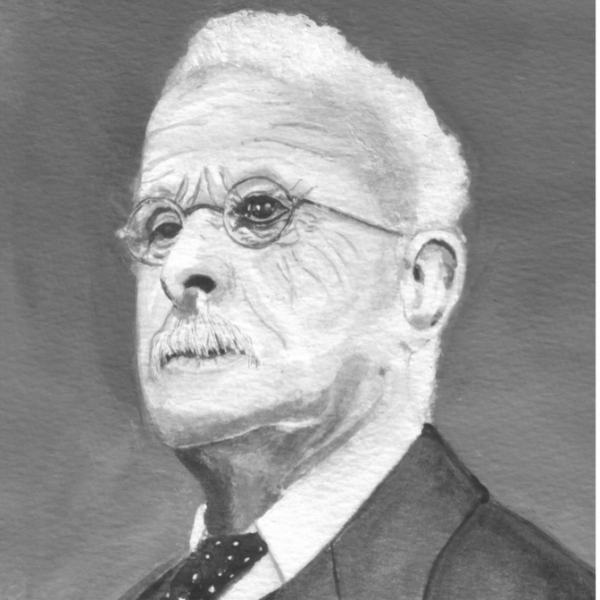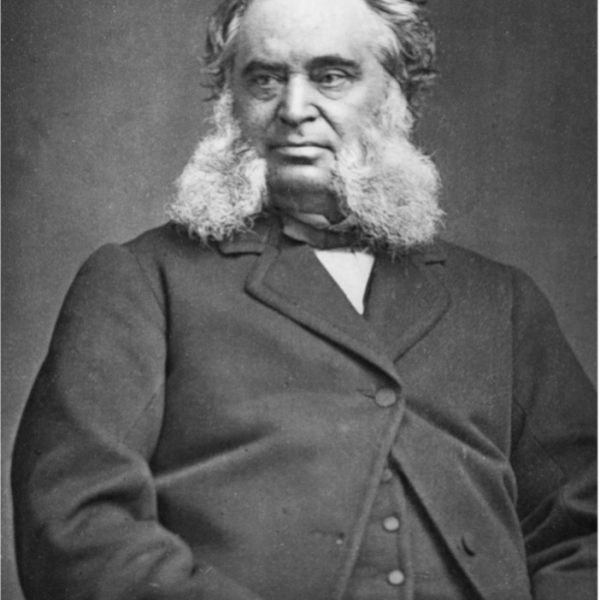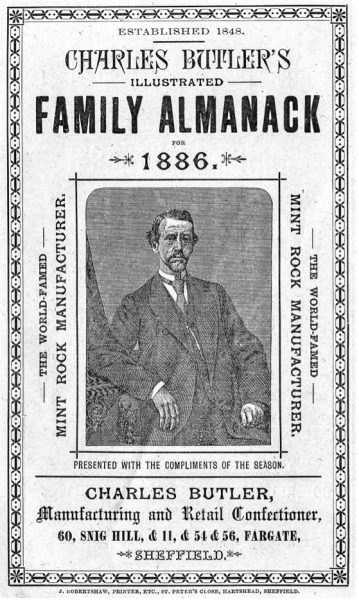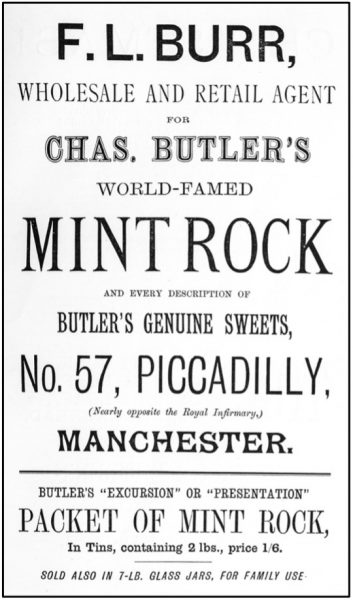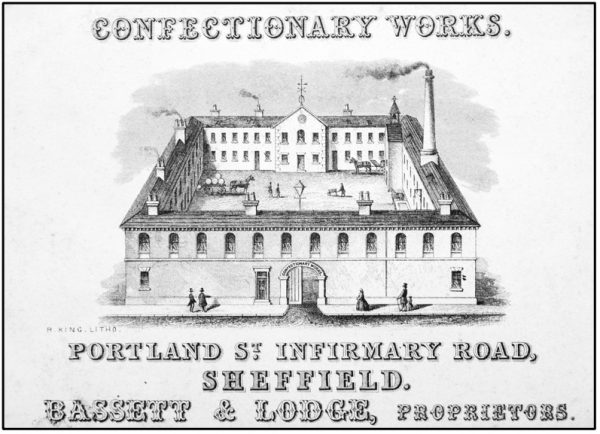
Today, we tend to think of a confectioner as someone who sells or makes chocolates and sweets. This was not the case when the Cemetery opened; in the 1830s a confectioner would have been a shop keeper who made a range of sweet goods in his back room, such as cakes, pies, biscuits, breads and boiled sweets. Early sweets tended to be medicated lozenges. There were no big brands, very little advertising (as newspaper space was heavily taxed) and no mass production. George Bassett, a confectioner who embraced the changing methods and markets brought about by the Industrial Revolution, became a household name we know today.
2021 Heritage Open Days Festival
For the 2021 Heritage Open Days Festival, themed ‘Edible England’ we chose to feature three confectionery-related burials in Sheffield General Cemetery: Albert Simpkin, Henry Dixon and George Bassett. We had a lot of fun putting together our confectionery trail between the three graves, a display of antique tins from their companies, and an old-fashioned sweet stall (which featured modern confections relating to Simpkin and Dixon). All were much appreciated by our visitors. We also looked at how Victorians used food to announce a death, with some surprisingly tasty funeral biscuits to sample.
Continued research
Encouraged by the incredible response to our confectionery display by visitors, and supported by the Parks for People project, we decided to continue the research to see how many confectioners were connected to Sheffield General Cemetery and to discover the hidden stories behind their graves. Additionally, one of the main themes of The National Lottery Heritage Funded Parks for People project, at Sheffield General Cemetery, was ‘Industrial Connections’. Focusing on Sheffield’s confectionery industry, which has had little research attention to date, constitutes significant heritage work for the Cemetery and the city. 174 graves have been identified and assessed, contributing to the stories told in our research. Of the 174 graves, 95 (55%) are in the Nonconformist area, where the memorials are most likely to be still in situ. Five Anglican memorials exist: Mary Brookes, Charles Butler, Elizabeth Johnson, William Pike and Wilfred Wright. 67 (39%) are public graves which did not have a memorial. The large number of child burials record a high mortality rate amongst the young, especially in the Victorian period. 114 graves (66%) contain one or more children under the age of 10. 105 of the graves relate to families who ran their own businesses. 112 people who actively worked as confectioners have been identified.
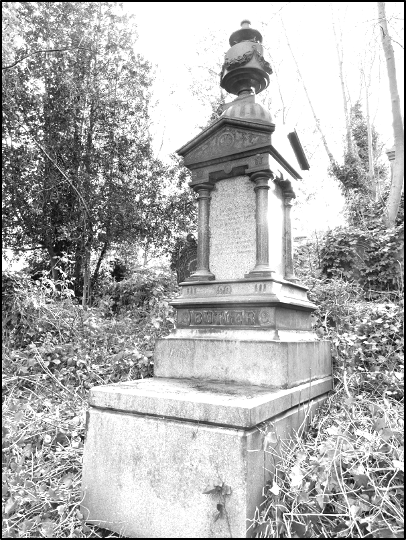
Anglican G1 91 Charles Butler
The earliest burial, related to the confectionery project was five-month-old Henry Charlesworth who was interred in grave Nonconformist G 147 on 27 December 1837, 19 months after the Cemetery opened. Thomas Charlesworth Snr., the grandfather of young Henry, was the first confectioner to be buried. Thomas, aged 78, was buried in grave Nonconformist G 144 on 1 March 1845. The final confectionery-related burial was Gertrude Dixon, wife of Henry Dixon Jnr., who was interred on 13 June 1968, aged 84. This was ten years prior to the last burial in the Cemetery, however. by the time Gertrude was buried, very few funerals were taking place and the Cemetery was in serious decline.
No doubt, George Bassett’s grave is one of the most well known in the Cemetery, however, it is not the most prominent of the confectioners’ memorials. Originally, George Bassett’s memorial had an obelisk which would have doubled its current height. The obelisk has now fallen but is still beside the memorial.
The most impressive confectionery memorials are those of Samuel and Charles Butler, and Robert Waterhouse. These memorials were choked with ivy when this project began; the Trust was not aware of their significance. Most of the memorials still in situ are straightforward headstones.
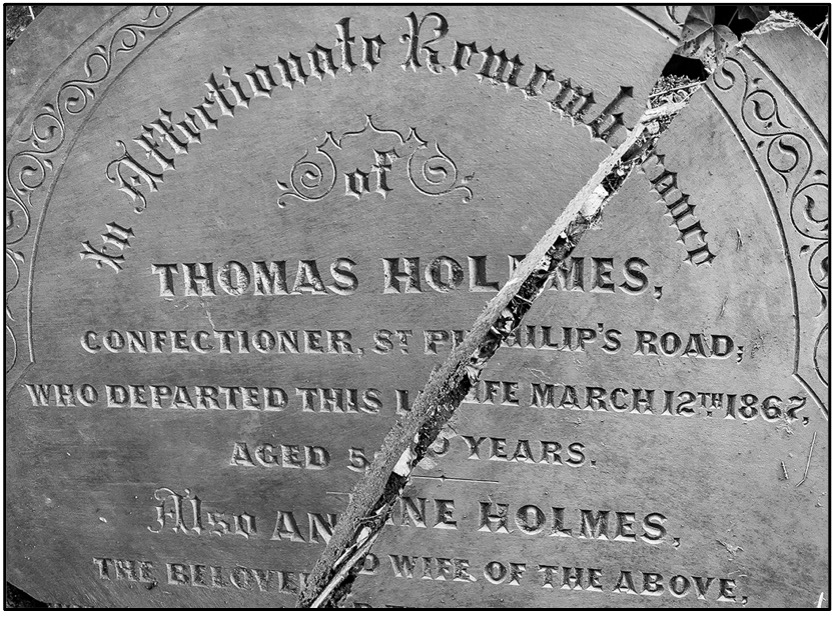
Nonconformist H 95 Thomas Holmes
Only three memorials have been discovered that record ‘confectioner’, even though there was a tendency in the Victorian period to state a man’s profession on his grave. These memorials are: Anglican G1 91 Charles Butler, Anglican U1 132 Elizabeth Johnson (a moved and badly damaged stone) and Nonconformist H 95 Thomas Holmes (also a damaged stone).
We have chosen the name “Sweet Remembrance” for the outputs of our project, having discovered that Henry Dixon used this phrase looking back on a happy life with his wife. Henry was a leading Sheffield confectionery manufacturer, and he and Elizabeth are buried in the Cemetery.
Our book
Our book “Sweet Remembrance”, authored by our volunteer Andrew Littlewood, is packed with 232 pages of fascinating information, and many untold stories about the Sheffield confectionery trade and the confectioners buried in the Cemetery.
Our exhibition
At Weston Park Museum, from 28th March to 11th June 2023 we will be showcasing our project with a free exhibition. This eclectic display of items from Sheffield’s confectionery history, including original confectionery artefacts, is suitable for the whole family. Find the display on the main corridor as you enter the museum.
We also encourage you to explore the confectionery-related memorials in the Cemetery. In Sweet Remembrance there is a map featuring some of the graves, and this map is also being made freely available in a leaflet – look out for copies across the city. Don’t forget your sweets to enjoy as you hunt out the graves!
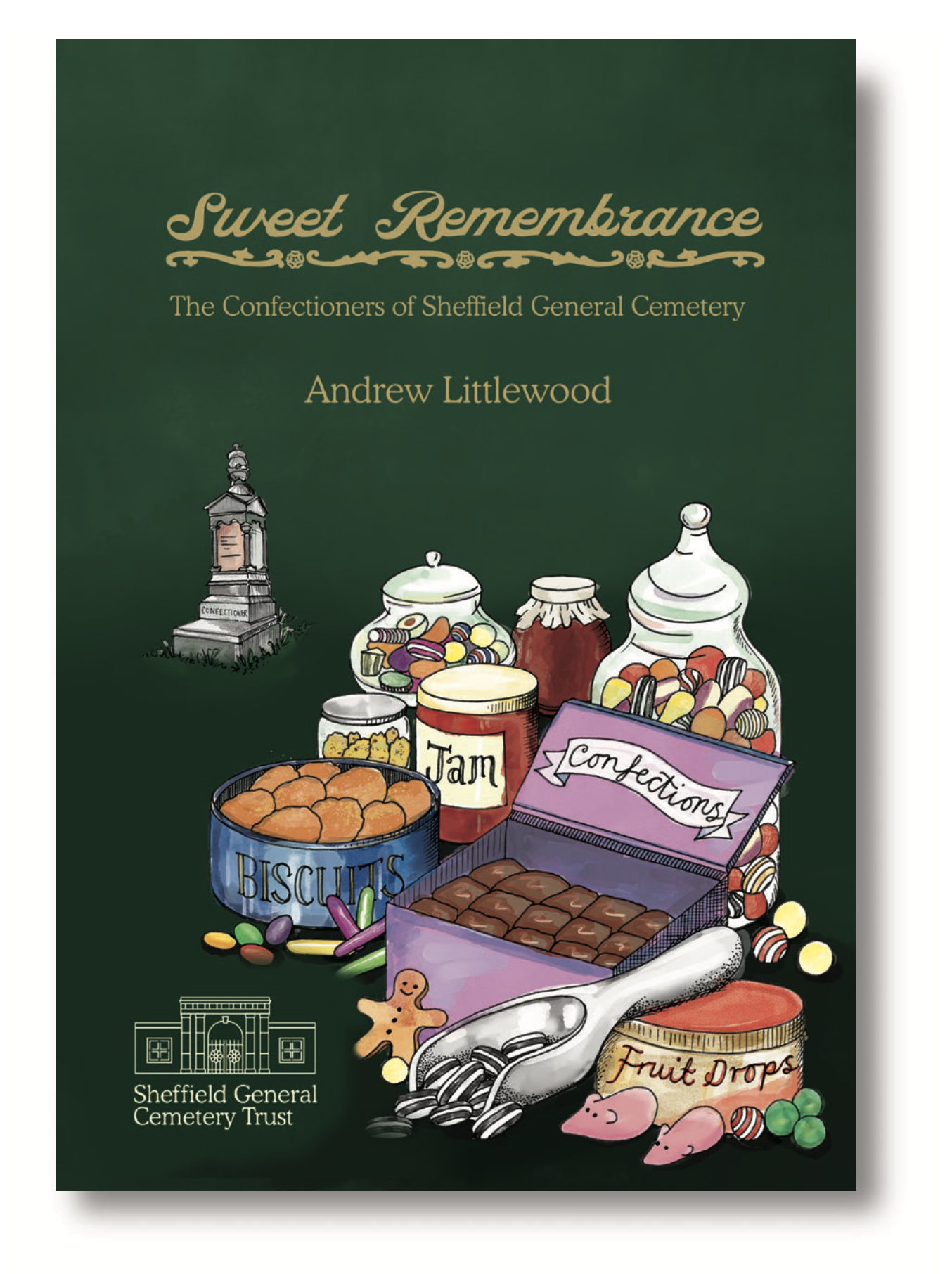
Audio trail
Our Sweet Remembrance Audio Trail guides you around the Cemetery to 12 locations (18 graves) and gives a brief history of each confectioner.
For those who like the human touch, our confectionery expert, Andrew, will be leading some Sweet Remembrance History Tours in the summer. Look out for details and book early as we expect these to be very popular.
Finally, for those who wish to delve deeper into this fascinating subject, all our research will be publicly available through Sheffield Archive and Local Studies Library.
Here is a taster of the goodies that you will find in Sweet Remembrance:
- Henry Dixon, a portrait by Alison Rowen, especially commissioned for the Sweet Remembrance project.
- George Bassett
- Charles Butler’s Family Almanack 1886
- Charles Boler funeral biscuit card
- Charles Butler’s Family Almanack 1886
- Bassett & Lodge advertising card c1860
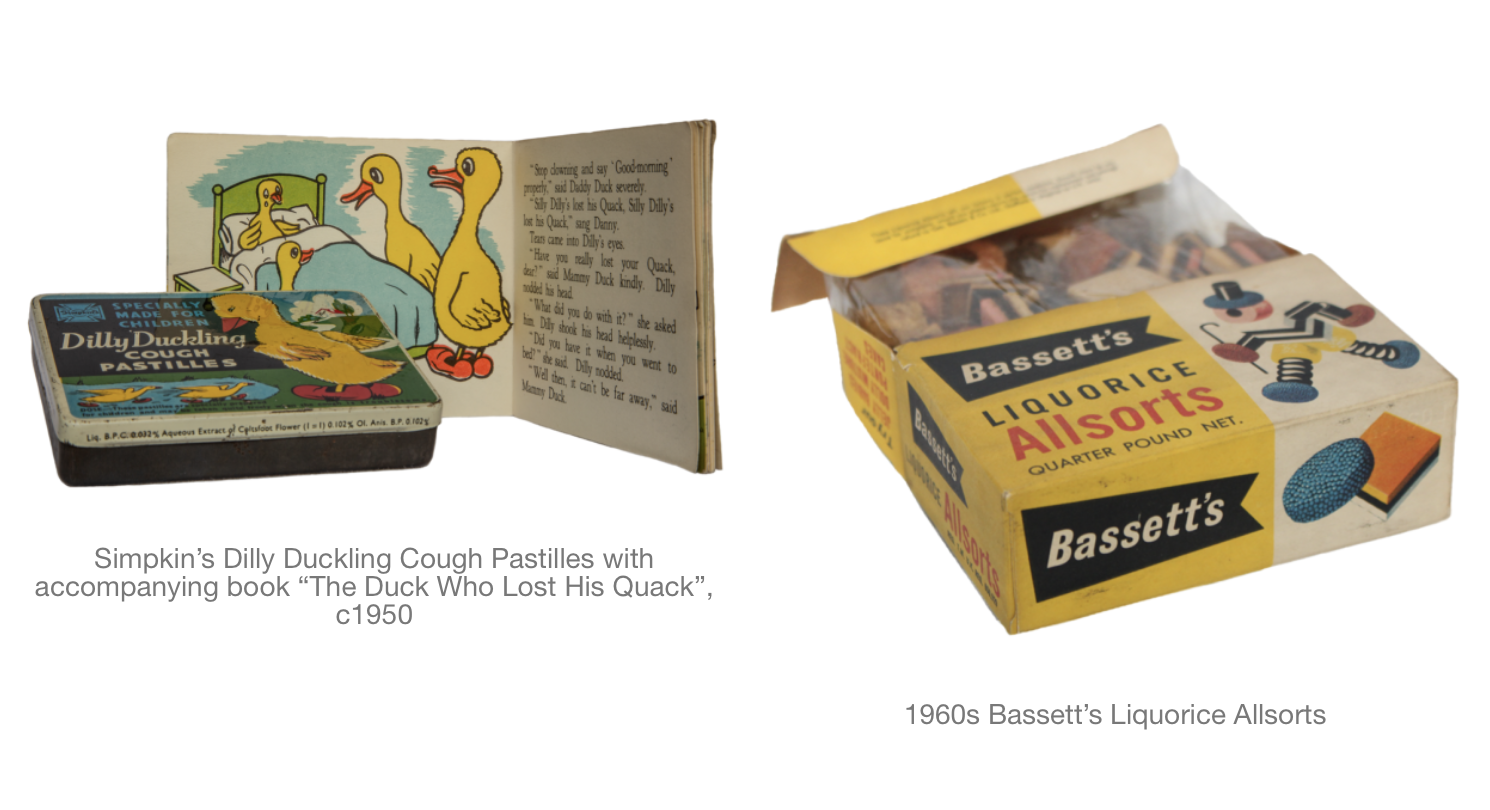

Don Confectionery Co. Ltd. were a leading Sheffield manufacturer of medicated sweets from the 1880s to 1930s.
- Where was their factory?
- Whose death led to ‘The Don’ being established? – clue: they are buried in the Cemetery!
- What does “C” stand for in the name of the sweets?
Get our book Sweet Remembrance to find out the answers!





